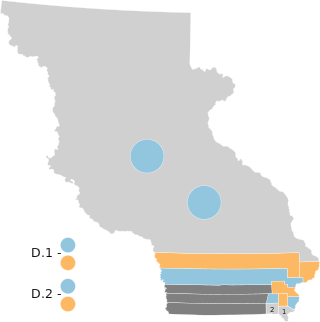
The 1839—1840 United States Senate election in New York was held on February 5, 1839 and January 14, 1840. Incumbent Senator Nathaniel P. Tallmadge was re-elected to a second term in office over scattered opposition.

The 1840–41 United States Senate elections were held on various dates in various states. As these U.S. Senate elections were prior to the ratification of the Seventeenth Amendment in 1913, senators were chosen by state legislatures. Senators were elected over a wide range of time throughout 1840 and 1841, and a seat may have been filled months late or remained vacant due to legislative deadlock. In these elections, terms were up for the senators in Class 2.

In the 1873 Iowa State Senate elections, Iowa voters elected state senators to serve in the fifteenth Iowa General Assembly. Elections were held in 23 of the state senate's 50 districts. State senators serve four-year terms in the Iowa State Senate.

In the 1838 Iowa Territory Council elections, electors selected councilors to serve in the first Iowa Territory Council. All 13 members of the Territory Council were elected. Councilors served one-year terms.

In the 1839 Iowa Territory Council elections, electors selected councilors to serve in the second Iowa Territory Council. All 13 members of the Territory Council were elected. Councilors served one-year terms.

In the 1841 Iowa Territory Council elections, electors selected councilors to serve in the fourth Iowa Territory Council. All 13 members of the Territory Council were elected. Councilors served one-year terms.

In the 1842 Iowa Territory Council elections, electors selected councilors to serve in the fifth Iowa Territory Council. All 13 members of the Territory Council were elected. Councilors served one-year terms.

In the 1843 Iowa Territory Council elections, electors selected councilors to serve in the sixth Iowa Territory Council. All 13 members of the Territory Council were elected. Councilors served one-year terms.

In the 1844 Iowa Territory Council elections, electors selected councilors to serve in the seventh Iowa Territory Council. All 13 members of the Territory Council were elected. Councilors served one-year terms.

In the 1845 Iowa Territory Council elections, electors selected councilors to serve in the eighth and final Iowa Territory Council before Iowa attained statehood in 1846. All 13 members of the Territory Council were elected. Councilors served until the organization of the Iowa General Assembly in 1846 as the legislative branch of the new state of Iowa.

In the 1846 Iowa State Senate elections, Iowa voters elected state senators to serve in the first Iowa General Assembly. Elections were held for all 19 members of the State Senate. In the newly created Senate, members were to serve four-year terms. Members of the first General Assembly were classified into two groups. Nine of the newly elected senators would serve full four-year terms, while 10 drew short terms of two years and were up for re-election in 1848. This classification process began the rotation system whereby half the members of the Senate are elected biennially for full four-year terms.

In the 1852 Iowa State Senate elections, Iowa voters elected state senators to serve in the fourth Iowa General Assembly. Following the expansion of the Iowa Senate from 19 to 31 seats in 1852, elections were held for 22 of the state senate's 31 seats. State senators serve four-year terms in the Iowa State Senate.

In the 1854 Iowa State Senate elections, Iowa voters elected state senators to serve in the fifth Iowa General Assembly. Elections were held for 19 of the state senate's 31 seats. State senators serve four-year terms in the Iowa State Senate.

In the 1856 Iowa State Senate elections, Iowa voters elected state senators to serve in the sixth Iowa General Assembly. Following the expansion of the Iowa Senate from 31 to 36 seats in 1856, elections were held for 21 of the state senate's 36 seats. State senators serve four-year terms in the Iowa State Senate.

In the 1859 Iowa State Senate elections, Iowa voters elected state senators to serve in the eighth Iowa General Assembly. Following the expansion of the Iowa Senate from 36 to 43 seats in 1859, elections were held for 27 of the state senate's 43 seats. State senators serve four-year terms in the Iowa State Senate.

In the 1863 Iowa State Senate elections, Iowa voters elected state senators to serve in the tenth Iowa General Assembly. Following the downsizing of the Iowa Senate from 49 to 46 seats in 1863, elections were held for 34 of the state senate's 46 seats. State senators serve four-year terms in the Iowa State Senate.

In the 1865 Iowa State Senate elections, Iowa voters elected state senators to serve in the eleventh Iowa General Assembly. Following the expansion of the Iowa Senate from 46 to 48 seats in 1865, elections were held for 23 of the state senate's 48 seats. State senators serve four-year terms in the Iowa State Senate.

In the 1867 Iowa State Senate elections, Iowa voters elected state senators to serve in the twelfth Iowa General Assembly. Following the expansion of the Iowa Senate from 48 to 49 seats in 1867, elections were held for 34 of the state senate's 49 seats. State senators serve four-year terms in the Iowa State Senate.

In the 1869 Iowa State Senate elections, Iowa voters elected state senators to serve in the thirteenth Iowa General Assembly. Following the expansion of the Iowa Senate from 49 to 50 seats in 1869, elections were held for 21 of the state senate's 50 seats. State senators serve four-year terms in the Iowa State Senate.
Mortimer Phillips Bainbridge was an American politician.








